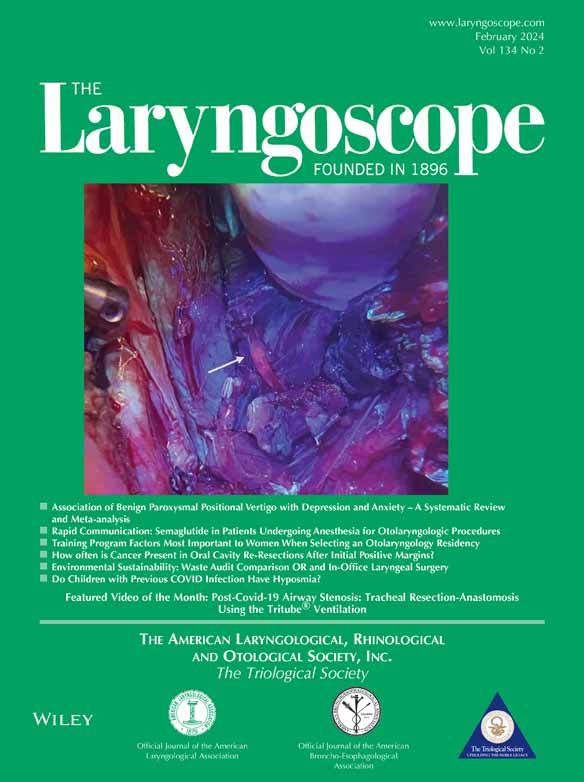Semaglutide in Patients Undergoing Anesthesia for Otolaryngologic Procedures
The authors have no funding, financial relationships, or conflicts of interest to disclose.
INTRODUCTION
With over five million prescriptions written in 2022, glucagon-like peptide 1 receptor agonists (GLP-1 RAs) are popular choices for diabetes management and weight loss. Medications in this class include semaglutide (Ozempic, Rybelsus, Wegovy). GLP-1 RAs work by decreasing appetite, improving glucose tolerance, and slowing gastrointestinal motility. Reduced gastrointestinal (GI) motility translates to greater residual gastric content even after fasting and higher risk of aspiration under anesthesia. Aspiration can lead to pneumonia, hypoxia, acute respiratory distress syndrome (ARDS), and death. Given these potential consequences, we examined perioperative use of GLP-1 RAs.
DISCUSSION
Silvera assessed residual gastric content (RGC) following 12 h fast in patients undergoing elective endoscopy.1 “Increased RGC” constituted any solid food between the esophagus and pylorus or suction canister volume greater than 0.8 mL/kg body weight. Among patients with increased RGC, 8 of 27 (29.6%) took semaglutide. In those without increased RGC, this statistic was 25 of 371 (6.6%). Propensity-weighted analysis revealed a propensity ratio of 5.15 for patients taking semaglutide. Thus, even after adjusting for age and medical comorbidities, semaglutide use is associated with a meaningful increase in residual gastric content after a fast deemed adequate for most anesthesia patients.
Sherwin used gastric ultrasound to assess impact of current semaglutide use and RGC after a 10-h fast.2 Ultrasonography in the left lateral position (performed by examiners blinded to patient semaglutide use) revealed RGC in 9 of 10 semaglutide users but only 1 of 10 non-users. While limited by small sample size, this study provides additional evidence that semaglutide use correlates with residual gastric content after fasting.
Case reports attest to danger in semaglutide use before anesthesia. Fujino presents the case of a 31 year old woman with type II diabetes and class III obesity (BMI 45) undergoing esophagogastroduodenoscopy (EGD) after fasting to solid food for 10 h.3 After administration of general anesthesia, endoscopy visualized a large quantity of solid food. The procedure was aborted due to safety concerns; however, repeating the procedure after a 36-h fast showed no solid food on endoscopy. This report suggest that longer fasting intervals may be necessary to resolve gastric retention in patients on semaglutide.
Gulak presents the case of a 48 year old woman with a 5-month history of semaglutide use (last dose 2 days prior) undergoing breast biopsy.4 Induction with general anesthesia resulted in regurgitation of copious amounts of clear fluid. The patient was turned to the lateral decubitus position; suctioning revealed an additional 200 mL of clear gastric contents. Similarly, Klein tells of a 42-year-old man with a 2-month history of semaglutide use undergoing endoscopy for esophageal dysplasia who aspirated despite remaining NPO for 18 h pre-procedure.5
Current knowledge convincingly associates semaglutide with aspiration risk in patients undergoing anesthesia. No studies examined the role of other GLP-1 RAs. Further research will refine recommendations on use of semaglutide perioperatively. Patient age, comorbidities, and body habitus likely alter aspiration risk in ways these studies do not completely account for. Additionally, there may be a role for a longer fasting interval in these patients. Based on available evidence, the American Society of Anesthesiologists (ASA) recommends that patients taking weekly GLP-1 agonists (Ozempic) take their last dose no later than the week before surgery and that patients taking daily GLP-1 agonists (Rybelsus, Wegovy) take their last dose no later than the day before surgery.6
CONCLUSION
Semaglutide is associated with increased residual gastric content and documented reports of aspiration under anesthesia. Given these risks, patients undergoing planned anesthesia should discuss this medication with their surgeon prior to surgery, with a plan to hold their most current dose prior to surgery.




